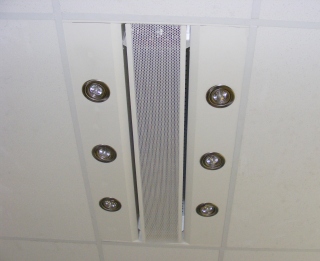Beaming good technology

Chilled beams and free cooling offer a persuasive combination when it comes to improving a building’s carbon footprint — says Rick Edmondson, of Waterloo Air Products.
Market awareness about the efficacy and benefits of using chilled beams received a major fillip last year when the Chilled Beam & Ceiling Association (CBCA) published its guide to chilled beams. But the publication also caused quite a controversy and re-opened the debate on the energy-saving benefits of chilled beams.
With the relentless rise of electricity costs, tighter building controls and the demands for buildings to be more energy efficient and function smarter building owners are under immense pressure to meet energy targets, comply with increasingly stringent legislation whilst driving down costs and protecting their bottom line.
As a result building owners are far more aware of new technologies, their environmental obligations and favouring chilled beams — a tried-and-tested technology that is proven to make a significant contribution towards lowering a building’s energy costs.
However, it is not just chilled beams that are attracting considerable interest but free-cooling systems that can generate further savings, but are dependent on the overall system design and on the selection of equipment for use.
Free cooling is highly topical — from commercial buildings to data centres. Free cooling offers an environmentally friendly and economical method of using the low external air temperatures for cooling and can further improve the green credentials of chilled beams.
Like most traditional systems, chilled beams are supplied with cooling from central chiller plant. Water is pumped through a circuit from the chiller to the chilled beam, which removes heat from the space, before returning to the chiller.
However chilled beams use a higher chilled-water temperature at 14 to 17°C, which for large parts of the year provide the option of using a free cooling chiller so that partial or 100% free cooling can be achieved. This can lessen the need for large refrigeration systems, which can also reduce both cooling energy consumption and the size of cooling plant.
Chilled beams provide excellent thermal comfort, conserve energy and provide efficient use of space. The operating principles of the system are simple and trouble free. Applications are extensive and include commercial buildings, hospitals, schools and hotel rooms.
The benefits of good energy efficiencies, low noise levels and no contaminant mixing are very attractive, but a free-cooling chiller and the opportunities to use what is essentially free air, adds further value.
The benefits of free cooling include the following.
• Use of cold air outside is free.
• Reduced running use of your existing compressors.
• Reduced wear and tear due to the reduced hours of operation of mechanical plant.
• Increases longevity of existing plant
• Reduced power costs.
Although free-cooling chillers can be more expensive, their costs must be weighed against the potential energy savings. In many cases the cost of energy is sufficiently high to make even the limited use of free cooling worthwhile.

Chilled beams can also offer energy savings related to chiller efficiencies. Chilled-beam systems require that higher temperature chilled water be supplied to the beams. The flow temperature to terminal units and fan-coil units may be 6 to 8°C, whereas with chilled-beam systems, chilled water should be supplied at temperatures no lower than 14°C, but this is dependent on location and environment as the dew point is the key factor. This difference in flow temperature may produce significant increases in chiller energy efficiency. The need to reheat cooled air is decreased by the provision of higher chilled-water supply temperatures and by the mixing of the treated primary air supply with a large volume of entrained air from the room.
Maintenance costs can often take up a huge chunk of a facilities manager’s budget, but the operation and maintenance of chilled-beam systems is very simple, reliable, and less likely to require maintenance or any replacement parts.
Because air is supplied by fans upstream of the device, there are no moving parts in the beam itself that may be susceptible to wear. In most designs filtration occurs upstream, so replacement filters are not required. Service costs are minimal. Infrequent and/or necessary vacuuming of the coil when required, which can be accessed via a hinged front panel in most devices, is typically all the maintenance required for the beam itself, which has a positive impact on whole life costs.
The following features all contribute to low maintenance costs for chilled beams.
• No condensate pump.
• No fans.
• No motors.
• No moving parts.
• No filter.
• No consumables.
• Simple on/off controls.
• 20 year lifespan.
Architects and engineers are mindful of legislation, and energy-savvy clients who want their buildings to perform optimally and are continually looking for systems that use minimal energy to deliver excellent internal environments. In addition to reducing emissions and improving a building’s carbon footprint, they are also mindful of total cost of ownership and reducing lifecycle costs. By taking an holistic view and planning properly integrated solutions that make use of the latest technologies further savings can be achieved, making chilled beams an even more attractive solution.
Rick Edmondson is chairman of Waterloo Air Products.







